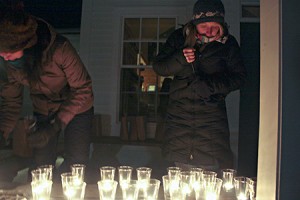

copyright the Chronicle December 10, 2014
by David Dudley
CRAFTSBURY — Roughly 40 people gathered on Craftsbury Common Sunday night to hold a candlelight vigil in response to police violence against black Americans.
Julia Lou Lepping, a student at Sterling College from Louisville, Kentucky, organized the vigil. As the 40 people, who all carried candles, filled the center of the snow-covered common, they formed a circle.
Though it was dark, and two degrees below zero, a full moon bathed the group in cool light.
“I wanted to create a space,” Ms. Lepping said. “To make a container for us all to pour our love into, and our thoughts, anything we need to say. And send it away to Ferguson, and New York City.”
Ms. Lepping was compelled, as many people across the United States have been, to peacefully protest the recent decisions to not indict officers Darren Wilson, of the Ferguson Police Department in Missouri, and Daniel Pantaleo, of the New York Police Department in New York City.
Mr. Wilson shot and killed unarmed teenager Michael Brown in Ferguson, Missouri, on August 9.
Some witnesses to the shooting claimed that Mr. Brown, who was accused of theft from a nearby store, was unarmed and had his hands in the air.
Mr. Wilson claimed that he felt that his life was threatened, and that Mr. Brown “looked like a demon.”
Officer Pantaleo was recorded as he placed Eric Garner in a chokehold in July.
In the video, Mr. Garner, who was also unarmed, could be heard repeatedly saying: “I can’t breathe” as the officers restrained him. The officers didn’t release Mr. Garner, who was lying face down on the ground, despite his pleas. Mr. Garner died shortly after the video was made.
In both cases, grand juries decided not to indict the officers, setting off a series of protests in cities all over the country. But, unlike some, such as those in Berkeley, California, and Ferguson, Missouri, which devolved into chaos, the vigil held in Craftsbury was peaceful. It was intended to heal.
“Garner’s death was on video,” Ms. Lepping said. “They played it in court. It was right there for everybody to see. He wasn’t armed. He wasn’t violent. He was choked to death, and the officer went free. I just don’t understand how that could happen.”
Many at the vigil had questions about police accountability and racial justice. And many shared their thoughts and experiences with racial inequality and injustice.
One woman expressed her discontent with the progress Americans have made regarding racism.
“I thought things had gotten better,” she said. “But it turns out we’ve got a long way to go.”
One young man wondered what he could do to help. He said he felt that coming to the vigil was a small action.
Another woman responded, saying that small actions have the potential to make big change.
“I feel like I’ve been doing anti-racism work for years now,” Ms. Lepping said. “And, with all of this news, I feel so lost. How can I help to push us forward?”
It was important for those present to stand in solidarity with the people of those communities.
Natalie Bekkouche, also a student at Sterling, attended the vigil because, as she put it, it’s easy to feel isolated in Vermont.
“It’s so easy to forget what’s happening in the rest of the world,” Ms. Bekkouche said.
Seth Fineman, a junior at Sterling, said that he couldn’t support the injustice happening to minorities in America.
“I came out tonight because I’m infuriated by the events of this past week,” Mr. Fineman said. “I wanted to gather with like minded people, to let them know that I am a resource. I want to do my part to send healing energy to those communities and to the Earth.”
Many people in the circle asked the same question: What can I do to help?
While the answer to that question will be different for each individual who approaches it seriously, the consensus was that dialogue is more necessary than ever.
“I don’t really like to use the word help,” Ms. Lepping said, “because it implies that the community can’t do it themselves. I don’t believe that. Maybe in this case it’s true. I don’t know.
“What I do know is that it will take all of us to challenge the problem of racism. And we’ve still got a long way to go.”
contact David Dudley at [email protected]
For more free articles from the Chronicle like this one, see our Featuring pages. For all the Chronicle’s stories, subscribe:
Print subscription
Annual online subscription
Short-term online subscription







